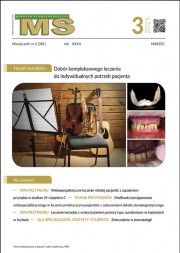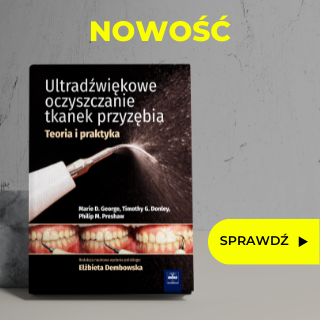Dostęp do tego artykułu jest płatny.
Zapraszamy do zakupu!
Po dokonaniu zakupu artykuł w postaci pliku PDF prześlemy bezpośrednio pod twój adres e-mail.
Piśmiennictwo
1. Guzik Ł, Kamysz E. Kserostomia – więcej niż suchość w jamie ustnej. Farm Pol. 2009; 65(6): 411-414.
2. Darczuk D, Ryba B. Kserostomia – wyzwanie dla lekarza. Med Trib Stomatol. 2014; 8. Online: https://podyplomie.pl/stomatologia/17305,kserostomia-wyzwanie-dla-lekarza
[dostęp 7.11.2019].
3. Bansal P. Modified Schirmer Test: A New Sialometric Tool. Journal of Oral Health & Research. 2014; 5: 1.
4. Davies AN, Broadley K, Beighton D. Xerostomia in Patients with Advanced Cancer. Journal of Pain and Symptom Management. 2001; 22(4): 820-825.
5. Thomson WM i wsp. The Xerostomia Inventory: a multi-item approach to measuring dry mouth. Community Dent Health. 1999;16: 12-17.
6. Pochwalski M, Wojtowicz A. Suchość jamy ustnej – kserostomia – przyczyny, objawy, metody leczenia – przegląd piśmiennictwa. Nowa Stomatol. 2003; 4: 211-216.
7. Ahadian H i wsp. Oral Complications of The Oromaxillofacial Area Radiotherapy. Asian Pac J Cancer Prev. 2017; 18(3): 721-725.
8. Gandhi K i wsp. Prevalence of Oral Complications occurring in a Population of Pediatric Cancer Patients receiving Chemotherapy. Int J Clin Pediatr Dent. 2017; 10(2): 166-171.
9. Minhas S i wsp. Concomitant-chemoradiotherapy-associated oral lesions in patients with oral squamous-cell carcinoma. Cancer Biol Med. 2017; 14(2): 176-182.
10. Naidu MU i wsp. Chemotherapy-Induced and/or Radiation Therapy-Induced Oral Mucositis – Complicating the Treatment of Cancer. Neoplasia. 2004; 6(5): 423-431.
11. Villa A, Akintoye SO. Dental Management of Patients Who Have Undergone Oral Cancer Therapy. Dent Clin North Am. 2018; 62(1): 131-142.
12. Velten DB i wsp. Prevalence of oral manifestations in children and adolescents with cancer submitted to chemotherapy. BMC Oral Health. 2017; 17(1): 49.
13. Volpato LE i wsp. Radiation therapy and chemotherapy-induced oral mucositis. Braz J Otorhinolaryngol. 2007; 73(4): 562-568.
14. Amézaga J i wsp. Assessing taste and smell alterations in cancer patients undergoing chemotherapy according to treatment. Support Care Cancer. 2018; 26(12): 4077-4086.
15. Muddugangadhar BC i wsp. A clinical study to compare between resting and stimulated whole salivary flow rate and pH before and after complete denture placement in different age groups. J Indian Prosthodont. 2015; 15(4): 356-366.
16. Arbabi-Kalati F, Arbabi-Kalati F, Moridi T. Evaluation of the effect of low level laser on prevention of chemotherapy-induced mucositis. Acta Med Iran. 2013; 51(3): 157-162.
17. Teguh DN i wsp. Risk model and nomogram for dysphagia and xerostomia prediction in head and neck cancer patients treated by radiotherapy and/or chemotherapy. Dysphagia. 2013; 28(3): 388-394.
18. Terlević Dabić D i wsp. The Effectiveness of Low-Level Laser Therapy in Patients with Drug-Induced Hyposalivation: A Pilot Study. Photomed. Laser Surg. 2016; 34(9): 389-393.
19. Sherlock S, Way M, Tabah A. Hyperbaric oxygen treatment for the management of radiation-induced xerostomia. J Med Imaging Radiat Oncol. 2018; 62(6): 841-846.
20. Kavitha M, Mubeen K, Vijayalakshmi KR. A study on Evaluation of efficacy of bethanechol in the management of chemoradiation-induced xerostomia in oral cancer patients. J Oral Maxillofac Pathol. 2017; 21(3): 459-460.















